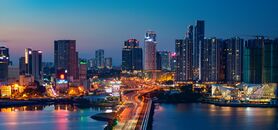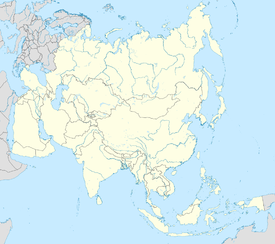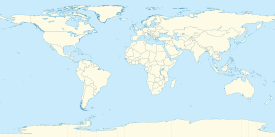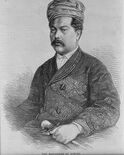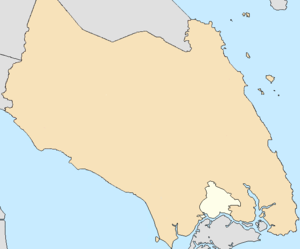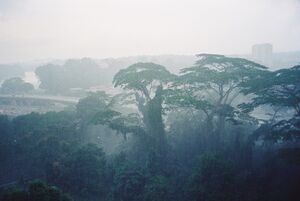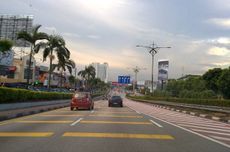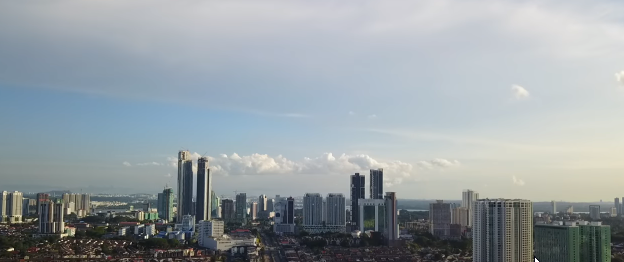جوهر بحرو
Johor Bahru | |
|---|---|
City and state capital | |
| City of Johor Bahru Bandaraya Johor Bahru | |
| الترجمة اللفظية بالـ Other | |
| • Jawi | جوهر بهرو |
| • Chinese | 新山 |
| • Tamil | ஜொஹோர் பாரு |
From top, left to right: Downtown skyline at night, Johor Causeway and Johor Bahru Sentral the transport hub in Southern Integrated Gateway, Tebrau Highway leading on to city centre, Forest City (Hutan Bandar) Recreational Park, Danga Bay Recreational Park, the Sultan Ibrahim Building, the Sultan Abu Bakar Mosque, and the Figure Museum | |
| الكنية: JB, Bandaraya Selatan (Southern City) | |
| الشعار: Johor Bahru Bandar Raya Bertaraf Antarabangsa, Berbudaya dan Lestari (إنگليزية: Johor Bahru, an International, Cultural and Sustainable City) | |
 Location of Johor Bahru in Johor | |
| الإحداثيات: 01°27′20″N 103°45′40″E / 1.45556°N 103.76111°E | |
| Country | |
| State | |
| District | Johor Bahru |
| Administrative areas | List
|
| Founded | 10 March 1855 (as Tanjung Puteri) |
| Municipality status | 1 April 1977 |
| City status | 1 January 1994 |
| الحكومة | |
| • الكيان | Johor Bahru City Council |
| • Mayor | Dato' Haji Adib Azhari Bin Daud |
| المساحة | |
| • City and state capital | 220٫00 كم² (84٫94 ميل²) |
| • الحضر | 1٬064 كم² (411 ميل²) |
| • العمران | 2٬217 كم² (856 ميل²) |
| المنسوب | 32 m (105 ft) |
| التعداد (2010)[3] | |
| • City and state capital | 663٬307 |
| • الكثافة | 2٬259/km2 (5٬850/sq mi) |
| • Urban | 1٬277٬244 (3rd) |
| • الكثافة الحضرية | 1٬200/km2 (3٬000/sq mi) |
| • العمرانية | 1٬805٬000 |
| • الكثافة العمرانية | 814/km2 (2٬110/sq mi) |
| صفة المواطن | Johor Bahruans |
| منطقة التوقيت | UTC+8 (MST) |
| • الصيف (التوقيت الصيفي) | UTC+8 (Not observed) |
| Postal code | 80xxx to 81xxx |
| Area code(s) | 07 |
| Vehicle registration | J |
| الموقع الإلكتروني | www |
جوهر بهرو مدينة ماليزيا وعاصمة ولاية جوهر. It is located along the Straits of Johor at the southern end of Peninsular Malaysia. The city has a population of 663,307 within an area of 220 km2. Johor Bahru is adjacent to the city of Iskandar Puteri, both anchoring Malaysia's third largest urban agglomeration, Iskandar Malaysia, with a population of 1,638,219.[4][5]
Johor Bahru was founded in 1855 as Tanjung Puteri when the Sultanate of Johor came under the influence of Temenggong Daeng Ibrahim. The area was renamed "Johore Bahru" in 1862 and became the capital of the Sultanate when the Sultanate administration centre was moved there from Telok Blangah.[6]
During the reign of Sultan Abu Bakar, there was development and modernisation within the city; with the construction of administrative buildings, schools, religious buildings, and railways connecting to Woodlands in Singapore. Johor Bahru was occupied by the Japanese forces from 1942 to 1945. Johor Bahru became the cradle of Malay nationalism after the war and gave birth to a political party named United Malays National Organisation (UMNO) in 1946. After the formation of Malaysia in 1963, Johor Bahru retained its status as state capital and was granted city status in 1994.
أصل الاسم
The present area of Johor Bahru was originally known as Tanjung Puteri, and was a fishing village of the Malays. Temenggong Daeng Ibrahim then renamed Tanjung Puteri to Iskandar Puteri once he arrived in the area in 1858 after acquiring the territory from Sultan Ali;[7] before it was renamed Johor Bahru by Sultan Abu Bakar following the Temenggong's death.[6] (The suffix "Bah(a)ru" means "new" in Malay, normally written "baru" in standard spelling today but appearing with several variants in place names, such as Kota Bharu and Indonesian Pekanbaru.) The British preferred to spell its name as Johore Bahru or Johore Bharu,[8] but the current accepted western spelling is Johor Bahru, as Johore is only spelt Johor (without the letter "e" at the end of the word) in the Malay language.[9][10] The city is also spelt as Johor Baru or Johor Baharu.[11][12]
The city was also once known as "Little Swatow (Shantou)" by the Chinese community in Johor Bahru, as most of Johor Bahru's Chinese residents are Teochew people whose ancestry can be traced back to Shantou, China. They arrived in the mid 19th century, during the reign of Temenggong Daeng Ibrahim.[13]
التاريخ

Due to a dispute between the Malays and the Bugis, the Johor-Riau Sultanate was split in 1819 with the mainland Johor Sultanate came under the control of Temenggong Daeng Ibrahim while the Riau-Lingga Sultanate came under the control of the Bugis.[14][15] The Temenggong intended to create a new administration centre for the Johor Sultanate to create a dynasty under the entity of Temenggong.[16] As the Temenggong already had a close relationship with the British and the British intended to have control over trade activities in Singapore, a treaty was signed between Sultan Ali and Temenggong Ibrahim in Singapore on 10 March 1855.[17] According to the treaty, Ali would be crowned as the Sultan of Johor and receive $5,000 (in Spanish dollars) with an allowance of $500 per month.[18] In return, Ali was required to cede the sovereignty of the territory of Johor (except Kesang of Muar which would be the only territory under his control) to Temenggong Ibrahim.[18] When both sides agreed on Temenggong acquiring the territory, he renamed it Iskandar Puteri and began to administer it from Telok Blangah in Singapore.[6]
As the area was still an undeveloped jungle, Temenggong encouraged the migration of Chinese and Javanese to clear the land and to develop an agricultural economy in Johor.[19] The Chinese planted the area with black pepper and gambier,[20] while the Javanese dug parit (canals) to drain water from the land, build roads and plant coconuts.[21] During this time, a Chinese businessman, pepper and gambier cultivator, Wong Ah Fook arrived; at the same time, Kangchu and Javanese labour contract systems were introduced by the Chinese and Javanese communities.[19][22][23] After Temenggong's death on 31 January 1862, the town was renamed "Johor Bahru" and his position was succeeded by his son, Abu Bakar, with the administration centre in Telok Blangah being moved to the area in 1889.[6]
الادارة البريطانية

In the first phase of Abu Bakar's administration, the British only recognised him as a maharaja rather than a sultan. In 1855, the British Colonial Office began to recognise his status as a Sultan after he met Queen Victoria.[24] He managed to regain Kesang territory for Johor after a civil war with the aid of British forces and he boosted the town's infrastructure and agricultural economy.[24][25] Infrastructure such as the State Mosque and Royal Palace was built with the aid of Wong Ah Fook, who had become a close patron for the Sultan since his migration during the Temenggong reign.[26] As the Johor-British relationship improved, Abu Bakar also set up his administration under a British style and implemented a constitution known as Undang-undang Tubuh Negeri Johor (Johor State Constitution).[24] Although the British had long been advisers for the Sultanate of Johor, the Sultanate never came under direct colonial rule of the British.[27] The direct colonial rule only came into effect when the status of the adviser was elevated to a status similar to that of a Resident in the Federated Malay States (FMS) during the reign of Sultan Ibrahim in 1914.[28]
In Johor Bahru, the Malay Peninsula railway extension was finished in 1909,[29] and in 1923 the Johor–Singapore Causeway was completed.[30] Johor Bahru developed at a modest rate between the First and Second World Wars. The secretariat building—Sultan Ibrahim Building—was completed in 1940 as the British colonial government attempted to streamline the state's administration.[31]
الحرب العالمية الثانية
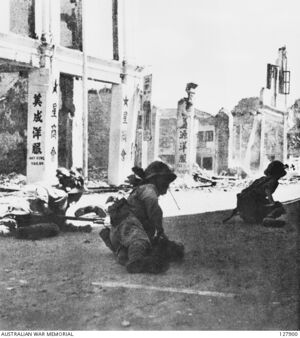
بعد الاستقلال
After the formation of the Federation of Malaysia in 1963,[32] Johor Bahru continued as the state capital and more development was carried out, with the town's expansion and the construction of more new townships and industrial estates. The Indonesian confrontation did not directly affect Johor Bahru as the main Indonesian landing point in Johor was in Labis and Tenang in Segamat District as well Pontian District.[33][34] There is only one active Indonesian spy organisation in the town, known as Gerakan Ekonomi Melayu Indonesia (GEMI). They frequently engaged with the Indonesian communities living there to contribute information for Indonesian commandos until the bombing of the MacDonald House in Singapore in 1965.[35][note 1] By the early 1990s, the town had considerably expanded in size, and was officially granted a city status on 1 January 1994.[36] Johor Bahru City Council was formed and the city's current main square, Dataran Bandaraya Johor Bahru, was constructed to commemorate the event. A central business district was developed in the centre of the city from the mid-1990s in the area around Wong Ah Fook Street. The state and federal government channelled considerable funds for the development of the city—particularly more so after 2006, when the Iskandar Malaysia was formed.[37][38] However, more than 10 years of unbridled building construction in Iskandar, especially of higher end high-rise apartments and commercial property, has led to a serious glut of such property in the region. Occupancy of high-rise accommodation has been predicted to fall to 50 percent, and commercial property to 65 percent, by the end of 2019 due to continued incoming supply.[39]
الحوكمة

الجغرافيا
Johor Bahru is located along the Straits of Johor at the southern end of Peninsular Malaysia.[40] Originally, the city area was only 12.12 km2 (4.68 sq mi) in 1933 before been expanded to over 220 km2 (85 sq mi) in 2000.[1]
المناخ
The city has an equatorial climate with consistent temperatures, a considerable amount of rain, and high humidity throughout the course of the year. An equatorial climate is a tropical rainforest climate more subject to the Intertropical Convergence Zone than the trade winds and with no cyclone. Daily average temperatures range from 26.4 °C (79.5 °F) in January to 27.8 °C (82.0 °F) in April with an average annual rainfall of around 2،350 mm (93 in).[41] The wettest months, with 19 to 25 percent more rain than average, are April, November and December.[42] Although the climate is relatively uniform, it does show some seasonal variation due to the effects of monsoons, with noticeable changes in wind speed and direction, cloud cover and amount of rainfall. There are two monsoon periods each year, the first one between mid-October and January, which is the north-east Monsoon. This period is characterised by heavier rainfall and wind from the north-east. The second one is the south-west Monsoon, which hardly affects the rainfall in Johor Bahru, where winds are from the south and south-west. This occurs between June and September.[43]
| بيانات المناخ لـ Johor Bahru (1974–2000) | |||||||||||||
|---|---|---|---|---|---|---|---|---|---|---|---|---|---|
| الشهر | ينا | فب | مار | أبر | ماي | يون | يول | أغس | سبت | أكت | نوف | ديس | السنة |
| متوسط القصوى اليومية °س (°ف) | 31.0 (87.8) |
32.0 (89.6) |
32.5 (90.5) |
32.8 (91.0) |
32.5 (90.5) |
32.1 (89.8) |
31.5 (88.7) |
31.5 (88.7) |
31.5 (88.7) |
31.8 (89.2) |
31.3 (88.3) |
30.6 (87.1) |
31.8 (89.2) |
| متوسط الدنيا اليومية °س (°ف) | 21.9 (71.4) |
22.0 (71.6) |
22.4 (72.3) |
22.9 (73.2) |
23.1 (73.6) |
22.9 (73.2) |
22.4 (72.3) |
22.4 (72.3) |
22.4 (72.3) |
22.6 (72.7) |
22.7 (72.9) |
22.4 (72.3) |
22.5 (72.5) |
| متوسط تساقط الأمطار mm (inches) | 162.6 (6.40) |
139.8 (5.50) |
203.4 (8.01) |
232.8 (9.17) |
215.3 (8.48) |
148.1 (5.83) |
177.0 (6.97) |
185.9 (7.32) |
190.8 (7.51) |
217.7 (8.57) |
237.6 (9.35) |
244.5 (9.63) |
2٬355٫5 (92.74) |
| Average rainy days (≥ 1.0 mm) | 11 | 9 | 13 | 15 | 15 | 12 | 13 | 13 | 13 | 16 | 17 | 15 | 162 |
| Source: World Meteorological Organisation[42] | |||||||||||||
المدينة
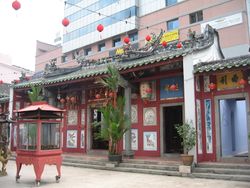
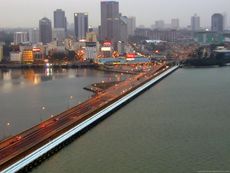
الاقتصاد
Johor Bahru is one of the fastest-growing cities in Malaysia after Kuala Lumpur.[44]It is the main commercial centre for Johor and is located in the Indonesia–Malaysia–Singapore Growth Triangle. Tertiary-based industry dominates the economy with many international tourists from the regions visiting the city.[44][45][46] It is the centre of financial services, commerce and retail, arts and culture, hospitality, urban tourism, plastic manufacturing, electrical and electronics and food processing.[47] The main shopping districts are located within the city, with a number of large shopping malls located in the suburbs. Johor Bahru is the location of numerous conferences, congress and trade fairs, such as the Eastern Regional Organisation for Planning and Housing and the World Islamic Economic Forum.[48][49] The city is the first in Malaysia to practise a low-carbon economy.[50]
The city has a very close economic relationship with Singapore. There are around 3,000 logistic lorries crossing between Johor Bahru and Singapore every day for delivering goods between the two sides for trading activities.[51] Many residents in Singapore frequently visit the city during the weekends; some of them have also chosen to live in the city.[44][45][46][52][53] Many of the city's residents work in Singapore.[54][55] In 2014, the sudden change by the Sultan of Johor of weekend rest days from Saturday and Sunday to Friday and Saturday had a relatively small impact to the city economy, with business especially affected. However, it could boost the tourism industry, since shops can now open on Sunday, attracting more tourists from Singapore.[56]
العلاقات الدولية
Several countries have set up their consulates in Johor Bahru, including Indonesia[57] and Singapore, while Japan has closed its consular office since 2014.[58]
البلدات التوأم - المدن الشقيقة
Johor Bahru currently has seven sister cities:
أنظر أيضاً
- معالم جوهر بحرو
- Daerah Sentral Johor Bahru
- Malaysia–Singapore Second Link
- Southern Integrated Gateway
- Karachi
ملاحظات
- ^ Another early attack to destabilise Malaysia was done with the murder of Malay trishaw in Singapore that led to the racial conflict between Malay and Chinese there. At the first stage of the conflict, it was alleged the murder was done by a Chinese but this was however turned down when further investigation revealed the murder was actually done by Indonesian agents who had infiltrate Singapore in an attempt to weakening the unity of race there during the state was still part of Malaysia. (Drysdale, Halim and Jamie)
المصادر
- ^ أ ب خطأ استشهاد: وسم
<ref>غير صحيح؛ لا نص تم توفيره للمراجع المسماةtotal area - ^ "Malaysia Elevation Map (Elevation of Johor Bahru)". Flood Map : Water Level Elevation Map. Archived from the original on 22 أغسطس 2015. Retrieved 22 أغسطس 2015.
- ^ "Total population by ethnic group, Local Authority area and state, Malaysia" (PDF). Statistics Department, Malaysia. 2010. Archived from the original (PDF) on 14 نوفمبر 2013. Retrieved 12 مارس 2012.
- ^ "Biggest Cities In Malaysia". World Atlas. Archived from the original on 25 نوفمبر 2017. Retrieved 28 نوفمبر 2016.
- ^ "JB can be Malaysia's second-biggest city: Johor Sultan". The Star/Asia News Network. The Straits Times. 24 مارس 2016. Archived from the original on 25 نوفمبر 2017. Retrieved 29 نوفمبر 2016.
- ^ أ ب ت ث "Background of Johor Bahru City Council and History of Johor Bahru" (PDF). Malaysian Digital Repository. 12 مارس 2013. Archived from the original (PDF) on 27 يونيو 2015. Retrieved 27 يونيو 2015.
- ^ Zainol Abidin Idid (Syed.) (19??). Pemeliharaan warisan rupa bandar: panduan mengenali warisan rupa bandar berasaskan inventori bangunan warisan Malaysia (in الماليزية). Badan Warisan Malaysia. ISBN 978-983-99554-1-5.
{{cite book}}: Check date values in:|date=(help) - ^ Margaret W. Young; Susan L. Stetler; United States. Department of State (أكتوبر 1985). Cities of the world: a compilation of current information on cultural, geograph. and polit. conditions in the countries and cities of 6 continents, based on the Dep. of State's "Post Reports". Gale. ISBN 978-0-8103-2059-8.
- ^ Gordon D. Feir (10 سبتمبر 2014). Translating the Devil: Captain Llewellyn C Fletcher Canadian Army Intelligence Corps In Post War Malaysia and Singapore. Lulu Publishing Services. pp. 378–. ISBN 978-1-4834-1507-9.
- ^ Cheah Boon Kheng (1 يناير 2012). Red Star Over Malaya: Resistance and Social Conflict During and After the Japanese Occupation, 1941–1946. NUS Press. pp. 13–. ISBN 978-9971-69-508-8.
- ^ Carl Parkes (1994). Southeast Asia Handbook. Moon Publications.
- ^ Library of Congress (2009). Library of Congress Subject Headings. Library of Congress. pp. 4017–.
- ^ "Keeping the art of Teochew opera alive". New Straits Times. AsiaOne. 24 يوليو 2010. Archived from the original on 24 يوليو 2015. Retrieved 24 يوليو 2015.
- ^ Donald B. Freeman (17 أبريل 2003). Straits of Malacca: Gateway or Gauntlet?. McGill-Queen's Press - MQUP. pp. 157–. ISBN 978-0-7735-7087-0.
- ^ Kanji Nishio (2007). Bangsa and Politics: Melayu-Bugis Relations in Johor-Riau and Riau-Lingga.
- ^ M. A. Fawzi Mohd. Basri (1988). Johor, 1855–1917: pentadbiran dan perkembangannya (in الماليزية). Fajar Bakti. ISBN 978-967-933-717-4.
- ^ "Johor Treaty is signed". National Library Board. 10 مارس 1855. Archived from the original on 30 يونيو 2015. Retrieved 30 يونيو 2015.
- ^ أ ب Abdul Ghani Hamid (3 أكتوبر 1988). "Tengku Ali serah Johor kepada Temenggung (Kenangan Sejarah)" (in الماليزية). Berita Harian. Retrieved 30 يونيو 2015.
- ^ أ ب ت "History of the Johor Sultanate". Coronation of HRH Sultan Ibrahim. 2015. Archived from the original on 2 يوليو 2015. Retrieved 2 يوليو 2015.
- ^ S. Muthiah (19 يونيو 2015). "The city that gambier built". The Hindu. Archived from the original on 19 أغسطس 2015. Retrieved 19 أغسطس 2015.
- ^ Carl A. Trocki (2007). Prince of Pirates: The Temenggongs and the Development of Johor and Singapore, 1784–1885. NUS Press. pp. 152–. ISBN 978-9971-69-376-3.
- ^ Patricia Pui Huen Lim (1 يوليو 2000). Oral History in Southeast Asia: Theory and Method. Institute of Southeast Asian Studies. pp. 119–. ISBN 978-981-230-027-0.
- ^ Patricia (2002), p. 129–132
- ^ أ ب ت Muzaffar Husain Syed; Syed Saud Akhtar; B D Usmani (14 سبتمبر 2011). Concise History of Islam. Vij Books India Pvt Ltd. pp. 316–. ISBN 978-93-82573-47-0.
- ^ Dominique Grele (1 يناير 2004). 100 Resorts Malaysia: Places with a Heart. Asiatype, Inc. pp. 292–. ISBN 978-971-0321-03-2.
- ^ Cheah Jin Seng (15 مارس 2008). Malaya: 500 Early Postcards. Didier Millet Pte, Editions. ISBN 978-981-4155-98-4.
- ^ Fr Durand; Richard Curtis (28 فبراير 2014). Maps of Malaysia and Borneo: Discovery, Statehood and Progress. Editions Didier Millet. pp. 177–. ISBN 978-967-10617-3-2.
- ^ "Johor is brought under British control". National Library Board. 12 مايو 1914. Archived from the original on 30 يونيو 2015. Retrieved 30 يونيو 2015.
- ^ Winstedt (1992), p. 141
- ^ Winstedt (1992), p. 143
- ^ Oakley (2009), p. 181
- ^ Arthur Cotterell (15 يوليو 2014). A History of South East Asia. Marshall Cavendish International Asia Pte Ltd. pp. 341–. ISBN 978-981-4634-70-0.
- ^ K. Vara (16 فبراير 1989). "Quiet town with a troubled past". New Straits Times. Retrieved 5 يوليو 2015.
- ^ "Indonesian Confrontation, 1963–66". Australian War Memorial. Archived from the original on 4 يوليو 2018. Retrieved 4 يوليو 2018.
- ^ Mohamed Effendy Abdul Hamid; Kartini Saparudin (2014). "MacDonald House bomb explosion". National Library Board. Archived from the original on 5 يوليو 2015. Retrieved 5 يوليو 2015.
- ^ "Background" (in الإنجليزية and الماليزية). Johor Bahru City Council. Archived from the original on 4 يوليو 2015. Retrieved 4 يوليو 2015.
- ^ Zaini Ujang (2009). The Elevation of Higher Learning. ITBM. pp. 46–. ISBN 978-983-068-464-2.
- ^ Oxford Business Group Malaysia (2010). The Report: Malaysia 2010 – Oxford Business Group. Oxford Business Group. pp. 69–. ISBN 978-1-907065-20-0.
{{cite book}}:|author=has generic name (help) - ^ Rachel Chew (16 يناير 2019). "JB's high-rise residences vacancy rate expected to hit an unprecedented above 50% this year". www.edgeprop.my. Retrieved 19 فبراير 2019.
- ^ Eric Wolanski (18 يناير 2006). The Environment in Asia Pacific Harbours. Springer Science & Business Media. pp. 349–. ISBN 978-1-4020-3654-5.
- ^ "Weather Data For Johor Bahru". Weatherbase. 25 فبراير 2019. Retrieved 25 فبراير 2019.
- ^ أ ب "World Weather Information Service – Johor Bahru". World Meteorological Organisation. Archived from the original on 23 أكتوبر 2013. Retrieved 25 مارس 2015.
- ^ "Malaysia". Climates To Travel. 25 فبراير 2019. Retrieved 25 فبراير 2019.
- ^ أ ب ت "Johor Bahru, a city on the move". South China Morning Post. 31 أغسطس 1996. Archived from the original on 26 يوليو 2015. Retrieved 26 يوليو 2015.
- ^ أ ب Aldo Tri Hartono (11 أغسطس 2014). "Wisata Belanja di Malaysia, Johor Bahru Tempatnya" (in الإندونيسية). DetikCom. Archived from the original on 26 يوليو 2015. Retrieved 26 يوليو 2015.
- ^ أ ب "Menikmati Johor Bahru Selangkah dari Singapura" (in الإندونيسية). Jawa Pos Group. 4 يوليو 2015. Archived from the original on 26 يوليو 2015. Retrieved 9 يوليو 2015.
- ^ "Flagship A: Johor Bahru City". Iskandar Regional Development Authority. Iskandar Malaysia. Archived from the original on 27 يوليو 2015. Retrieved 27 يوليو 2015.
- ^ "46th EAROPH Regional Conference, Iskandar, Malaysia, Thistle Hotel, Johor Bahru" (PDF). Eastern Regional Organisation for Planning and Housing. 2013. Archived from the original (PDF) on 27 يوليو 2015. Retrieved 27 يوليو 2015.
- ^ "8th WIEF Johor Bahru, Malaysia". 8th World Islamic Economic Forum. 2012. Archived from the original on 27 يوليو 2015. Retrieved 27 يوليو 2015.
- ^ "Low carbon city report focus on Johor Bahru, Malaysia". British High Commission, Kuala Lumpur. Government of the United Kingdom. 17 يوليو 2014. Retrieved 27 يوليو 2015.
- ^ "Malaysian transport, logistics providers welcome change in Woodlands Checkpoint toll charges". The Straits Times. 9 يناير 2018. Retrieved 23 يوليو 2018.
- ^ "JB calling". The Straits Times. 7 يوليو 2013. Archived from the original on 20 أغسطس 2015. Retrieved 20 أغسطس 2015.
- ^ Tash Aw (13 مايو 2015). "With more Singaporeans in Iskandar, signs of accelerating détente with Malaysia". The New York Times. The Malay Mail. Retrieved 26 يوليو 2015.
- ^ Zazali Musa (14 يوليو 2015). "Lure of the Singapore dollar". The Star. Retrieved 26 يوليو 2015.
- ^ "More M'sians prefer to earn S'pore wages". Daily Express. 15 يوليو 2015. Archived from the original on 26 يوليو 2015. Retrieved 26 يوليو 2015.
- ^ Dominic Loh (24 نوفمبر 2013). "Changed weekends could impact Johor's economy". My Sinchew. Retrieved 26 يوليو 2015.
- ^ "Consulate General of the Republic of Indonesia, Johor Bahru". Consulate General of Indonesia, Johor Bahru, Johor, Malaysia. Retrieved 2 يوليو 2015.
- ^ "Consular Office of Japan (Johor Bahru)". Embassy of Japan in Malaysia. Retrieved 5 مايو 2017.
- ^ Amanda (10 نوفمبر 2016). "Changzhou, Johor Bahru of Malaysia become sister-cities". JSChina.com.cn. Archived from the original on 5 مايو 2017. Retrieved 5 مايو 2017.
- ^ Liuxi (16 فبراير 2012). "First Cultural Exchange after Shantou and Johor Bahru becomes Sister Cities". Shantou Daily. Shantou Government. Archived from the original on 30 يونيو 2015. Retrieved 1 يوليو 2015.
- ^ "International Connections". Shantou Foreign and Oversea Chinese Affairs Bureau. Shantou Government. Archived from the original on 30 يونيو 2015. Retrieved 1 يوليو 2015.
- ^ Zazali Musa (10 مارس 2014). "Johor to strengthen trade and tourism activities with Guandong Province". The Star. Retrieved 1 يوليو 2015.
- ^ أ ب Yu Ji (27 أغسطس 2011). "Kuching bags one of only two coveted 'Tourist City Award' in Asia". The Star. Archived from the original on 1 يوليو 2015. Retrieved 1 يوليو 2015.
- ^ "Malaysian investors in Cotabato City". CotabatoCity.net.ph. Archived from the original on 5 مايو 2017. Retrieved 5 مايو 2017.
- ^ Helmut K Anheier; Yudhishthir Raj Isar (31 مارس 2012). Cultures and Globalization: Cities, Cultural Policy and Governance. SAGE Publications. pp. 376–. ISBN 978-1-4462-5850-7.
- ^ "Relations between Turkey and Malaysia". Ministry of Foreign Affairs. Archived from the original on 30 يونيو 2015. Retrieved 1 يوليو 2015.
وصلات خارجية
- Official site of Johor Bahru City Council
- جوهر بحرو travel guide from Wikitravel
- Johor Bahru Community Portal
- Johro Map and Street Photos
- Pages using gadget WikiMiniAtlas
- CS1 الماليزية-language sources (ms)
- CS1: Julian–Gregorian uncertainty
- CS1 errors: generic name
- CS1 الإندونيسية-language sources (id)
- EngvarB from July 2016
- Use dmy dates from July 2016
- Short description is different from Wikidata
- Pages using multiple image with auto scaled images
- Pages using infobox settlement with possible nickname list
- Articles containing إنگليزية-language text
- Pages using Lang-xx templates
- Pages using infobox settlement with possible motto list
- Coordinates on Wikidata
- Articles with hatnote templates targeting a nonexistent page
- Use dmy dates from December 2010
- جوهر بحرو
- أماكن مأهولة تأسست في 1855
- نقاط الحدود الماليزية السنغافورية
- أماكن مأهولة في جوهر
- مدن ماليزيا
- صفحات مع الخرائط
